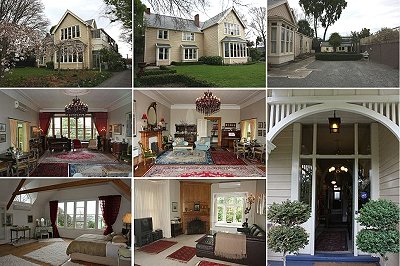
LARGE IMAGE OPENS IN A NEW WINDOW
Bill Moorhouse (1825-1881), as he was known upon embarking for New Zealand in 1851, was a Lawyer, trans-Tasman ship owner, Editor of the Lyttelton Times, Real Estate speculator, Registrar-General of Lands, Politician, Superintendent of Canterbury, Mayor of Wellington and a Bankrupt.
Superintendent Sefton Moorhouse, as he came to prefer being known, bought 50 acres of Charlotte Jackson's Merevale Farm in the Papanui district in 1862 and proceeded to build a 21-room clapboard palazzo, which he named Merevale House. The sheer expense precipitated bankruptcy the following year, and although completed, only a substantial part of his grandiose folly survives.
Successive owners have included John Thomas Peacock, Alfred Louisson, a Samuel Butler, John and Michael Studholme, Harry and Ada Wells, Charles Todhunter, Yvette Nicholls and Murray Hunter, Andrew and Jocelyn Allison, Patrick and Jo Kerr, and Christopher and Danielle Smith since 2000. Since the later 1950s the area has become known as the salubrious suburb of Merivale (sic).
The surviving part of his home is currently being offered for sale at $995,000, but curiously the marketing blurb makes no mention of any aspect of the historical significance of the five double-bedroomed house, now on a mere 831 square metres of land, at 31 Naseby Street, Merivale.
4 comments:
They must have read Canterbury Heritage, because listing does say, vaguely, "has a respected place in Canterbury's history" and html code accidentally on purpose hides something like "that we will tell you about privately (maybe) so you don't run into any trouble with the heritage or historic places folks when you bulldoze it flat & replace it with Albanian communist era bunker-style townhouses." It's all in the code... as any real estate agent will tell you ;)
I have inquired of the appropriate agent and been advised that the vendor assures that there are no historic preservation convenants etc on the property, but that I should confirm this for my own peace of mind.
It was also confirmed to me that this is, indeed, part of the Moorhouse estate. Not that I would, of course, seek to impeach Canterbury Heritage's reputation as to factual accuracy.
It may be just the piece of real estate I've been looking for...
sorry to hog the comments, just thought you might be interested in the update.
History may well continue, for the most part, to be soft science Down Under, but factual accuracy is of prime importance to Canterbury Heritage. To which effect the basis of our information system is a bespoke database that gorges on texts and images, regardless of format. Accordingly, we're always pleased to promptly amend published articles and have recently been able to accurately date the construction of the city's oldest surviving house to April, 1852 (an article will soon follow).
Our openly stated criticism of the Christchurch City Council's heritage preservation policy hasn't won us many friends in high places, particularly since we declined to suppress statistical information relating to the use of the Resource Management Act to circumvent heritage preservation issues.
We are also aware of an apparent major breach of the Historic Places Act by the Council, with what might appear to be the collusion of the regional office of the New Zealand Historic Places Trust (who have sought to exercise a right to preëmptive censorship of this publication). But rather than go head on with the bureaucratic establishment, we'd prefer to take a longer term view and pursue areas of common interest to the wider community's benefit...
And as to that future, you might be passably interested to know that although Canterbury Heritage is little more than a five minute wonder fronting a fancy information system, its readership is now somewhat larger than the national circulation of the Historic Places Trust magazine (and no adverts!).
Good luck with Merevale House (we have more information relating to its subsequent history).
In the light of further research and the pursuit of historical accuracy the text has been updated.
A chapter in Rodney Wells and Vicky Heward's Christchurch Heritage Houses (Caxton Press, 2004) gives further details of Merevale's reputed history.
Post a Comment